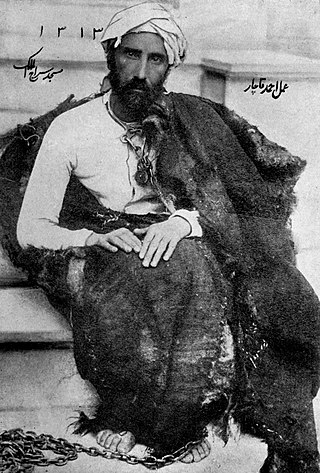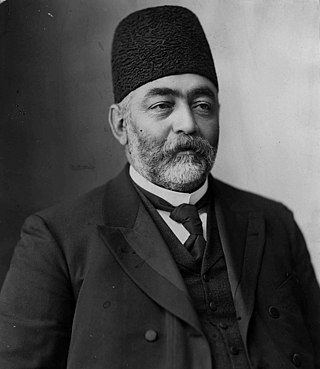| |||||
| Decades: | |||||
|---|---|---|---|---|---|
| See also: | Other events of 1853 Years in Iran | ||||
The following lists events that have happened in 1853 in the Qajar dynasty.
| |||||
| Decades: | |||||
|---|---|---|---|---|---|
| See also: | Other events of 1853 Years in Iran | ||||
The following lists events that have happened in 1853 in the Qajar dynasty.

The Golestan Palace, also transliterated as the Gulistan Palace and sometimes translated as the Rose Garden Palace from Persian language, was built in the 16th century, renovated in the 18th century and finally rebuilt in 1865. It is the former official royal Qajar complex in Tehran.

The Qajar dynasty was an Iranian royal dynasty founded by Mohammad Khan of the Qoyunlu clan of the Turkoman Qajar tribe.

Mohammad Ali Shah Qajar was the sixth shah of the Qajar dynasty and remained the Shah of Iran from 8 January 1907 until being deposed on 16 July 1909. He was furthermore the grandson of Iran’s early moderniser Amir Kabir, through the maternal side.

Mozaffar ad-Din Shah Qajar was the fifth Qajar shah of Iran, reigning from 1896 until his death in 1907. He is often credited with the creation of the Persian Constitution of 1906, which he approved of in one of his final acts as shah.

Naser al-Din Shah Qajar was the fourth Shah of Qajar Iran from 5 September 1848 to 1 May 1896 when he was assassinated. He was the son of Mohammad Shah Qajar and Malek Jahan Khanom and the third longest reigning monarch in Iranian history after Shapur II of the Sassanid dynasty and Tahmasp I of the Safavid dynasty. Naser al-Din Shah had sovereign power for close to 51 years.

Prince Iraj Mirza, titled Jalāl-ol-Mamālek, was a prominent Iranian poet. He was the son of Prince Gholam-Hossein Mirza. Iraj Mirza was known for his modern poetry, which often critiqued traditional customs. In addition to his original works, he translated literary pieces from French into Persian.

Reza-Qoli Khan Hedayat was an Iranian literary historian, administrator, and poet in 19th-century Qajar Iran.

Qajar art was the architecture, paintings, and other art forms produced under the Qajar dynasty, which lasted from 1781 to 1925 in Iran (Persia).
Prince Soltan Ali Mirza Kadjar (Qajar) (Persian: سلطانعلی میرزا قاجار; November 16, 1929 – May 27, 2011) was an Iranian Prince of Qajar dynasty and the son of Soltan Majid Mirza Qajar (1907–1975) and Homadokht Kian (Shayesteh Khanoum) (1912–1992) and the grandson of Mohammad Ali Shah Qajar. He was the Head of the Qajar Imperial Family. Despite Soltan Ali Mirza Qajar being Head of the Qajar Imperial Family, the Qajar claimant to the Sun Throne was the Heir Presumptive Mohammad Hassan Mirza II, son of Soltan Hamid Mirza and grandson of Soltan Ahmad Shah's brother and successor in exile, Mohammad Hassan Mirza Qajar.

Mirza Reza Kermani was an adherent of Jamal al-Din al-Afghani and an Iranian who assassinated King Nasser-al-Din.

Mirza Ali Asghar Khan, also known by his honorific titles of Amin al-Soltan and Atabak, served as Prime Minister of Iran from 1887 to 1896 under Naser ed-Din Shah Qajar, from 1898 to 1904 under Mozaffar ed-Din Shah Qajar and from May 1907 until his assassination in August 1907 under Moahammad Ali Shah Qajar.

Kamran Mirza was a Qajar prince and third surviving son of Naser al-Din Shah Qajar. He was the brother of Mass'oud Mirza Zell-e Soltan and Mozaffar ad-Din Shah Qajar. Kamran Mirza also served as Iran's Commander-in-Chief, appointed in 1868 for the first time, and minister of war from 1880 to 1896 and from 1906 to 1907.

Malek Jahan Khanom was the wife of Mohammad Shah Qajar and the mother of Naser al-Din Shah. She was the de facto regent of Iran for one month, from 5 September until 5 October in 1848, between the death of her husband and the accession of her son.

Jalal al-Din Mirza was an Iranian historian, philologist and freethinker, born in Tehran. He wrote a semi-historical book about the history of Iran named Name-ye Khosrovan, potentially one of the first comprehensive nationalistic works about the country.

The Guarded Domains of Iran, alternatively the Sublime State of Iran and commonly called Qajar Iran, Qajar Persia or the Qajar Empire, was the Iranian state under the rule of the Qajar dynasty, which was of Turkic origin, specifically from the Qajar tribe, from 1789 to 1925. The Qajar family took full control of Iran in 1794, deposing Lotf 'Ali Khan, the last Shah of the Zand dynasty, and re-asserted Iranian sovereignty over large parts of the Caucasus. In 1796, Agha Mohammad Khan Qajar seized Mashhad with ease, putting an end to the Afsharid dynasty. He was formally crowned as Shah after his punitive campaign against Iran's Georgian subjects.
The following lists events that have happened in 1896 in the Qajar dynasty.
The following lists events that have happened in 1907 in the Qajar dynasty.

Nahāvand Castle was an ancient castle from Sasanian Persia that was located in what is now the city of Nahavand in Hamedan province, Iran. The fall of this castle in the Battle of Nahavand was a major turning point in the Islamic conquest of Persia. Nonetheless, the castle survived up until the time of Naser al-Din Shah Qajar. It was said that when digging a qanat, Naser al-Din Shah found a treasure. He then ordered the castle to be destroyed in order to find more treasures; however, no more were found.

The Nassereddin Shah relief known as Shekl Shah and Shekl-e Shah is a rock relief commissioned by Naser al-Din Shah Qajar around 1879, showing the shah on horseback flanked by ten standing ministers. It is the latest in a tradition of large rock reliefs ordered by Iranian rulers. It is located on the Haraz road overlooking the Haraz river about 60 km from Amol in Mazandaran Province, Iran. It is close to an ancient Sassanid road. The work was ordered after the new road was built in 1879.
Mirza Mohammad Taqi Sepehr, also known as Mirza Mohammad Taqi Kashani, or with the honorific Lesan ol-Molk, was an Iranian court historian and littérateur of the Qajar era. He wrote with the pen name Sepehr, and is known for authoring the lengthy Persian chronicle Nasekh ol-tavarikh-e salatin-e Qajariyeh, also simply known as the Nasekh ol-tavarikh.